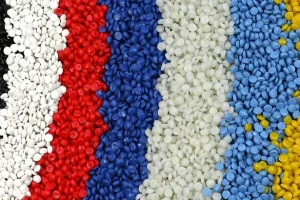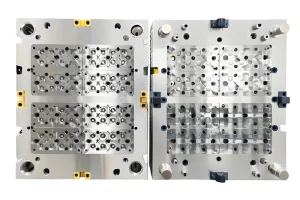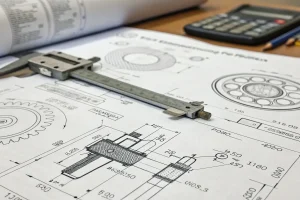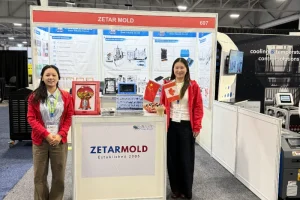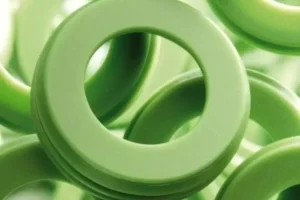Multi-shot plastic injection molding, which can also be called multi-component or 2K molding, is a high-tech manufacturing method for making complicated plastic parts. You can use different materials and colors in one cycle to create items that look good, work great—and have intricate designs with exactly the right material properties.

Introduction to Multi-Shot Plastic Injection Molding
Multi-shot plastic injection molding is a specialized process that makes it possible to manufacture parts with multiple colors or materials without requiring additional operations. This technique involves injecting several different materials into one mold multiple times; the end result is a single part which has properties of all the materials used in its production.

History and Evolution
Multi-shot molding has come a long way since it was first developed. Initially, there were many problems with how to combine different materials in one mold, including whether they would work together or how you even control a process like that. But over the years polymer science, plastic injection molding machine and also how molding itself works has both improved so much that these issues have been solved. Making multi-shot molding a viable and widely used manufacturing method today.

Importance in Modern Manufacturing
In today’s competitive market, producers are always looking for methods to make their products work better and look nicer – while also spending less time and money making them. Multi-shot injection moulding meets all these needs in a single process by enabling the manufacture of complex parts from different materials. This can eliminate post-production assembly processes, it may also be possible to incorporate functions such as sealing into a part during the same cycle.This capability is particularly important in industries such as automotive, medical devices, consumer electronics, and household goods, where precision and efficiency are paramount.

The Process of Multi-Shot Injection Molding
The multi-shot injection molding process involves several key steps, each critical to achieving a high-quality final product.
Step 1: Material Preparation
Various materials (thermoplastics, thermosets, or elastomers) are prepared in advance and prepared and loaded into different injection units. Their selection is usually based on properties they have (melting point, transparency, hardness, etc.) & those required in the end product. Proper material selection is crucial, as it ensures the compatibility and bonding of the different materials.

Step 2: First Injection
The first material is injected into the mold to form the initial part or component. This initial shot serves as the substrate for subsequent injections. The mold is designed to accommodate the first material and hold it in place during the next steps. Precision in this step is vital, as it sets the foundation for the subsequent layers.
Step 3: Mold Rotation or Transfer
The mold or part may be rotated or moved within the mold during multi-shot processing, depending on the method employed. This enables the second injection to take place in a new cavity or on another area of the first part. The mold design and the timing of the rotation or transfer are critical to ensure proper alignment and bonding of the materials.

Step 4: Second Injection (and Subsequent Injections)
The second material is added to the mold where it bonds with the first material. Repeat this step as many times as necessary to include all materials. Success depends on mold design and injection order; both factors determine how well the substances adhere to each other. To make sure parts don’t have defects and are uniformly strong, engineers must also control such variables closely throughout the process.
Step 5: Cooling and Ejection
After the materials are injected into the mold and bonded together, they are allowed to cool and solidify. The mold is opened to eject the finished part, and the process is then repeated to make the next part. Cooling time must be optimized to prevent warping, and the ejection process must be gentle to avoid damaging the part.

Types of Multi-Shot Injection Molding
Different applications and design requirements call for different types of multi-shot injection molding processes. Understanding these types helps in selecting the appropriate process for specific product needs.
Overmolding
Overmolding is when you mold a second material onto a substrate. Usually, it’s to give a hard plastic item a soft-touch surface or ergonomic qualities. One instance where this might be done is adding a rubber grip to a plastic tool handle. This process enhances the functionality and comfort of the product, making it more user-friendly.
Overmolding finds extensive application in items necessitating a mix of rigid and flexible materials, for example tool handles, electronic device housings and automotive parts. The technique’s main advantages are that it can improve grip, make products more attractive, and allow different material properties to be combined within one part.

Two-Shot Injection Molding
When using two-shot injection molding, also called 2K molding, involves inject two materials in sequence into one mold. This method is common when making items with separate functional areas or multicolored parts. It’s often used for producing things like automobile interiors, medical products and consumer electronics.
Double-shot molding involves injecting the first material and letting it cool partially. Then, either the mold rotates or the part gets moved to another cavity where the second material is injected. This technique makes it possible to create parts with intricate designs and specific material placement. Applications include automotive switches, medical syringes, and multi-colored consumer products.

Multi-Component Molding
Multi-component injection molding takes the idea of two-shot molding further by allowing for the use of more than two materials. By making it possible to integrate three or more different materials, this technique enables the creation of even more complex parts with additional capabilities. It finds application in situations calling for a blend of attributes, for example varying hardness or thermal resistances.
Multi-component molding (multi material injection molding) is used in advanced applications that require a high degree of precision and material diversity. It allows multiple materials to be combined in a single process, useful for making things like auto parts that include seals, medical tubing with several layers or electronic goods that need elaborate casings. As well as cutting down on how much assembling has to be done (therefore saving time/money), this technique also offers greater design control plus precision when putting together various material properties (such as rigid and flexible plastics).

Co-Injection Molding
Injecting two materials at once through one nozzle, that’s co-injection molding. You can inject them in layers so the outside is made of one material while another forms the inside. It’s great for making things such as lightweight interiors with tough exteriors (think car dashboards).
Co-injection molding is perfect for items needing a balance of strength and weight loss. The core material can be a lightweight, cost-effective polymer, while the outer shell provides durability and aesthetic appeal. Applications include automotive components, packaging containers, and consumer products.

Advantages of Multi-Shot Injection Molding
Multi-shot injection molding offers several significant advantages over traditional single-shot molding processes, making it an attractive option for various manufacturing applications.
Enhanced Product Design
Greater design flexibility is achieved when a single part can be made from more than one material. This means manufacturers can develop items with different colours, textures and functional zones, enhancing both aesthetics and functionality.
Multi-shot molding makes it possible to create new designs that cannot be achieved using single-shot molding. For instance, products could have soft-touch grips alongside transparent windows or integrated seals. This versatility allows designers to push the boundaries of what is possible in product design, leading to more appealing and functional products.

Improved Product Performance
When materials with varied characteristics are combined, it is possible for makers to increase how well a product works. For example, a part can have a rigid core for structural integrity and a soft outer layer for improved grip and comfort.
By combining materials, different features of product performance can be enhanced. This includes durability, chemical resistance and thermal stability. For example, by using both hard and soft substances a tool handle can be made stronger while also more comfortable, so users get the benefits of both things.

Cost Efficiency
Producing multiple shots in a single mold (same mold) removes the necessity of further operations like bonding or assembling parts together. Not only does this lower both production time and costs, it also reduces waste due to the precise way materials are injected.
Multi-shot molding has the potential to decrease production expenses by simplifying the manufacturing process. When items are made this way there may be no need for additional activities like welding or gluing which means not only does it take less time, but also fewer workers are necessary. Additionally, the precise control of material usage helps minimize waste, further contributing to cost savings.

Enhanced Durability
Items made with multi-shot molding are usually tougher and more reliable. When various materials become integrated on a molecular level during production, they adhere more strongly to one another and reduces the risk of delamination or separation.
Multi-color injection molding technology produces parts with strong bonds between materials. These parts have a longer service life, which is an essential feature when used in harsh conditions or exposed to mechanical stress. Products such as automotive parts and medical devices benefit from the increased reliability that multi-color injection molding brings.

Reduced Assembly Requirements
When multi-shot molding is used, it becomes possible to manufacture parts that are fully integrated, this means they require no further assembly steps. Because the manufacturing process is simplified, production cycles may be shorter and labor costs lower.
Multi-color molding combines different materials in a single cycle without the need for complex assembly later. Manufacturers using this process can manufacture products faster and also reduce the likelihood of assembly errors, thereby improving product quality and increasing consistency.

Applications of Multi-Shot Injection Molding
Multi-shot injection molding is used in a wide range of industries and applications due to its versatility and ability to produce high-quality injection molded parts.
Automotive Industry
Multi-shot molding is utilized in the automotive sector for making interior and exterior components that have different material properties. These can range from dashboard panels, control buttons and weather seals. What this process does is allow manufacturers to integrate both soft-touch surfaces with rigid structural elements into one single part.
One benefit of multi-shot molding for the automotive industry is that it enables manufacturers to make parts which make cars better both practically and aesthetically. For instance, a dashboard panel can be produced that combines hard and soft materials – so it’s tough wearing but comfortable to the touch. Control buttons can incorporate multiple colors and textures, improving both usability and appearance.

Medical Devices
Multi-shot molding is how medical devices like surgical instruments, syringes and medical tubing are made. This process puts together materials with different qualities, for example flexibility versus rigidity. The process ensures the precise combination of biocompatible materials.
Multi-shot molding within the medical industry allows for the creation of intricate tools that adhere to strict regulatory guidelines. For example, syringes may have a rigid body to enable exact control and a soft plunger for patient comfort. Medical tubing can combine flexible and rigid sections, enhancing both functionality and safety.

Consumer Electronics
Multi-shot molding in consumer electronics is used for producing pieces with several shades and intricate designs. For example smartphone keypads, housings, wearables. The process allows for the integration of functional and aesthetic features in a single molding cycle.
Manufacturers of consumer electronics can use multi-shot molding to make products that are not only sleek and stylish but also highly practical. For example, a smartphone housing could have different colours and textures which will make it more attractive while improving the user’s grip. Wearable devices can combine rigid and flexible materials to improve comfort and durability.

Household Goods
Items found in homes like kitchen tools, toothbrushes and parts for appliances benefit greatly from multi-shot molding. This process makes it possible to create components with ergonomic designs as well as long-lasting materials, enhancing user experience and product longevity.
In household goods, multi-color injection molding improves the functionality and aesthetics of everyday items. For example, kitchen tools can have a sturdy hard handle and a comfortable soft grip. Toothbrushes can have a variety of colors and patterns to make them more attractive and user-friendly.

Packaging
The packaging industry uses multi-color injection molding to produce closures and containers with different material properties. The process is able to create rigid body containers and flexible closures, ensuring durability and ease of use.
In the packaging industry, multi-color molding can create innovative and practical packaging solutions. Containers can have a durable body and a flexible seal, keeping the product safe and accessible. Multi-color and textured designs enhance the visual appeal and functionality of packaging.

Conclusion
A game-changer in manufacturing, multi-shot plastic injection molding provides matchless cost-effectiveness as well as scope for design and product performance improvements. It can create intricate parts that do more things by combining different materials and colors.

Multi-shot molding offers a wide range of benefits that make it an extremely valuable technique for any manufacturer wanting to innovate and improve their products. Today, this process is essential in state-of-the-art manufacturing because it provides enhanced design flexibility plus improved product performance, all at a lower cost with fewer assembly needs. Enhanced design flexibility, improved product performance, cost efficiency, and reduced assembly requirements are just a few of the advantages that make this process an essential tool in modern manufacturing.


